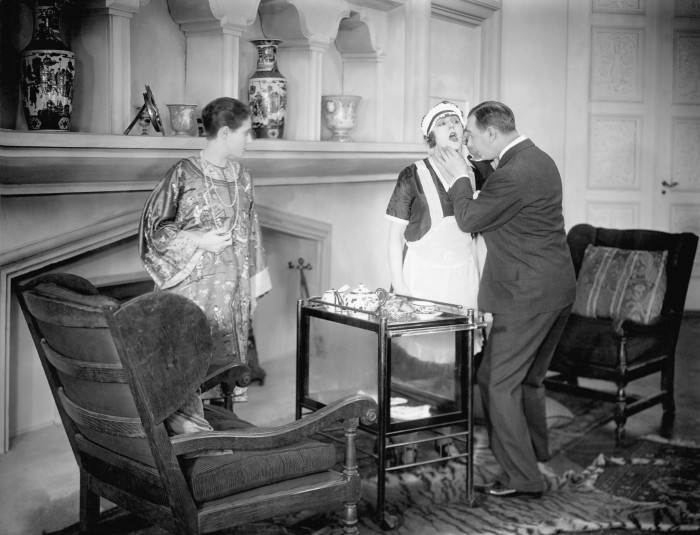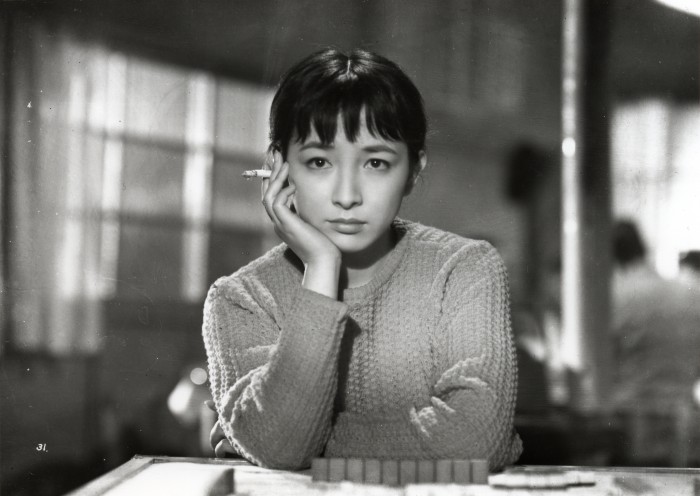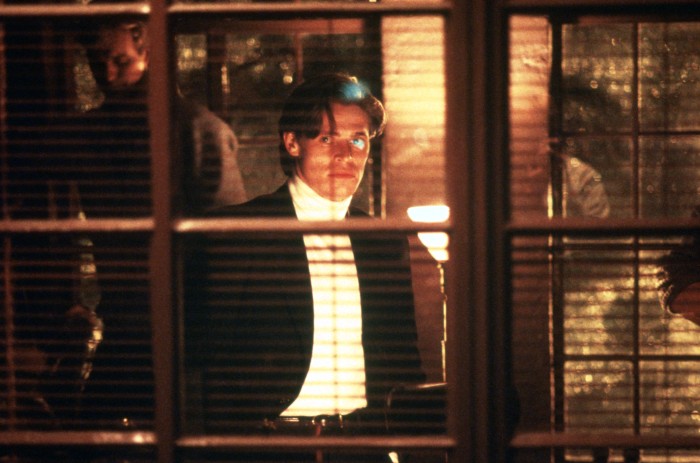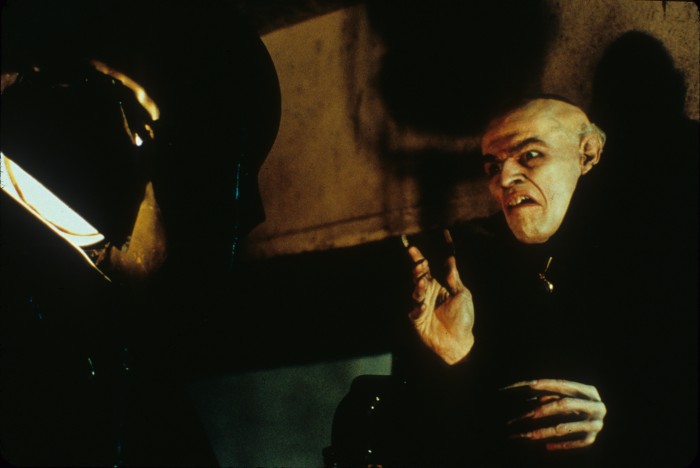Revived and Restored Films to See at Berlinale 2018

Greetings from Berlin. I'm attending the film festival here which is on from 15 - 25 February. There's a long list of new films to see, but I've also got my eye on the rich selection of old films that are included in this year's edition.
The Restrospective section this year is titled “Weimar Cinema Revisited”, focusing on cinema in the Weimar era. Between 1918 and 1933 it was one if the most productive and influential phases in Germanfilmmaking began unfolding, a creative era that went on to shape international perception of the country’s filmculture, even to the present day. The selection includes a total of 28 programmes of narrative, documentary,and short films made between 1918 and 1933.
The Berlinale Classics section features world premieres of a total of seven films in digitally restored versions,and the Homage section is dedicated to Willem Dafoe. Lastly, the Forum section includes a series of Special Screenings committed to an alternative view of film historiography.
Here are my top picks of revived/restored films to see at Berlinale, per section, listed in the order of the year each film wasoriginally released. I've also included the screening format. My list is focused on feature films only (there's along list of short films I recommend you look up if you are at the festival). Click on each title for more details(images and synposis extracts from the Berlinale website).
Restrospective - Weimar Cinema Revisited
Heaven on Earth
Director: Reinhold Schünzel Alfred Schirokauer
1927 | Germany 113 min | 35 mm | Restored Version 2013

Local representative Traugott Bellmann is a vocal critic of society’s moral decline in general and the notorious nightclub “Heaven on Earth” in particular. Just his luck that he inherits the place – along with half a million marks – and furthermore, on the day, of all days, that he is appointed president of the Moral Decency League! And just his luck that the terms of the inheritance from his deceased brother stipulate that Bellmann has tospend every night from ten to three in the morning in his newly-acquired “den of iniquity”.
Adding to the just his luck scenario is the fact that it all happens on Bellmann’s wedding day, with the daughter of a respectable champagne bottler waiting for her bridegroom in the bedroom … Shimmy, jazz, and Ziegfeld-style girl revues. With risqué innuendo and effervescent humour, the film turns elements of urbaneentertainment into an attack on the 1926 obscenity law.
Show Life
Director: Richard Eichberg
1928 | Germany / United Kingdom |125 min | 35 mm

This melodrama set in exotic locales is considered the most mature work of Richard Eichberg, a busy director who worked across all genres. With delicate Hollywood star Anna May Wong, and heavyweight Heinrich George as the leads, the film unfolds as a dazzling visual interplay of contrasts.
Moving between dive bar and cabaret, ocean liner and night train, this German-British co-production represented Weimar cinema’s first foray into the milieu of European ex-pats in a colonial setting, which wasvery attractive for western foreign markets.
Spring Awakening
Director: Richard Oswald
1929 | Germany | 95 min | 35 mm

Setting in the 1920s, the film explores “modern” youth culture, complete with cigarettes, jazz music, the gramophone, and a goodly bit of alcohol. Richard Oswald, a master of films of manners and young sex beginning in the 1910s, fully explores the temptations of the youthful body, even early childhood flirtatiousness. At the same time, with his target audience in mind, the film laments the bigotry and double standards of theadult world.
Her Majesty, Love
Director: Joe May
1931 | Germany 101 min | 35 mm

To provoke his brother Othmar, the director of Wellingen motor works, charming playboy Fred von Wellingen gets engaged to barmaid Lia Török. But the company needs a fresh influx of money, so Othmar wants Fred to marry the wealthy Miss Lingenfeld, and promises to promote Fred to general manager in return for giving up Lia. Fred, who by this time is genuinely in love with the barmaid, reluctantly accepts the deal.
The supporting actors are the stars in this tempestuous film operetta. In a mad dash to a surprise ending, a colourful chorus of song numbers, sketches, and artistic tomfoolery put those minor roles at the centre of attention – as filled by actors such as Ralph Arthur Roberts, Szöke Szakall, Otto Wallburg, and Adele Sandrock, who were an essential part of the rich pool of acting talent boasted by Weimar-era cinema.
The Blue Light
Director: Leni Riefenstahl
1932 | Germany | 86 min | 2K DCP Theatrical Release Version 1932, digitally restored 2018

In an isolated mountain village in the Dolomites, the painter Vigo meets a young woman named Junta. She is ostracised by the superstitious villagers who consider her a witch. They believe that numerous young men, lured by Junta’s beauty, have followed her towards a mysterious blue light on Monte Cristallo and fallen to theirdeaths. Vigo wins the affection of the shy hermit. He moves into her hut and one night, he discovers her secret.
For her directing debut, Leni Riefenstahl also wrote the script with critic Béla Balázs. The film was an outlier intwo respects. Made not only outside of the established Berlin studio system, it was also something of a ‘chick flick’ within the mountain film genre – movies made by and with men, and heavy on athleticism and documentary-style images.
Berlinale Classics
Tokyo Boshoku
Director: Yasujiro Ozu
1957 | Japan | 140 min | 4K DCP | Digitally restored version 2017

In a barren, cold Tokyo, a young woman is broken by her father’s harsh nature and silence. This largely-unknown work is considered Ozu’s darkest post-war film.
Fail Safe
Director: Sidney Lumet
1964 | USA | 112 min | Black/White | 4K DCP | Digitally restored version 2017

The film is an intimate drama about nuclear war. This taut psychological drama is based on the eponymous bestselling book published in 1962, the year of the Cuban missile crisis. It is an impressive critique of the Cold War military doctrine, with its portrayal of politicians and the military mired in the fatal logic of mutually assured destruction.
Wings of Desire
Director: Wim Wenders
1987 | Federal Republic of Germany / France | 129 min | 4K DCP | Digitally restored version 2018

Damiel and Cassiel, the film’s two main characters, are guardian angels – benevolent, invisible beings wearing long coats. They are unable to intervene in human lives, but they can hear the thoughts of mortals and attempt to comfort them. Damiel falls in love with trapeze artist Marion and wants to become human, even though thatmeans giving up immortality.
Peter Falk, playing himself as a former angel, has already taken that fateful step and urges Damiel to leave eternity behind too. The story is told from the point of view of the angels, who see the world in black and white. It is not until Damiel becomes human that the world of colour reveals itself to him.
My 20th Century
Director: Ildikó Enyedi
1989 | Hungary, Federal Republic of Germany | 105 min | 4K DCP | Digitally restored version 2017

A romantic love story, a poetic fairy tale, an erotic riddle – and at the same time, an inventory of new technology – electricity, the telegraph, film. Conceived as an homage to silent movies and shot in black-and-white, My 20th Century references many silent film techniques and tricks.
Homage
To Live and Die in L.A.
Director: William Friedkin
1985 | USA | 116 min | 2K DCP

In this action-packed thriller, Willem Dafoe is a kind of Mick Jagger of the local gangster milieu. His character has a sense of fashion reflected in his clothing and the decoration of his apartment, and a sexual ambivalence that he acts out in a liaison with his lesbian accomplice; he counters the machismo of the federal agent with sardonic charm.
Platoon
Director: Oliver Stone
1986 | USA | 120 min | 35 mm

In the autumn of 1967 during the Vietnam War, army volunteer Chris Taylor is assigned to an infantry platoon near the Cambodian border. He soon realises that he and his comrades have very little chance of surviving intheir fight against the Vietcong. He begins hanging out with a clique of pot-smoking GIs surrounding Elias Grodin, a veteran, disillusioned sergeant who believes the war has already been lost.
When a group of frustrated soldiers massacres the inhabitants of a Vietnamese village, Grodin threatens to turn them in. But theleader of the group is also the sergeant’s superior and during the next patrol, he takes steps to protect himself.
The Last Temptation of Christ
Director: Martin Scorsese
1988 | USA / Canada | 163 min | 2K DCP

Jesus, a Jewish carpenter from Bethlehem, who makes the crosses that the Roman occupiers use forexecutions, hears the voice of God. He gathers disciples around him and travels the land performing miracles.Judas, tasked with winning him over to the political resistance, also joins the group. In Jerusalem, Jesus bringsdown the ire of the religious and secular authorities upon himself.
But it is not until Judas betrays him that he is captured and nailed to a cross. Whereupon a guardian angelappears to him. In Martin Scorsese’s extremely controversial film adaptation of the eponymous novel, theredeemer is confronted with a range of worldly temptations, giving Dafoe a platform for one of his mostpowerful onscreen performances.
Mississippi Burning
Director: Alan Parker
1988 | 120 min | 35 mm

Mississippi, 1964. After driving through the night from the north, three young civil rights activists – two white and one black – disappear without a trace. Young FBI agent Alan Ward and his partner, Mississippian Rupert Anderson, are sent to investigate. But their inquiries are met with resistance at every turn, by racist locals, intimidated African-Americans, and first and foremost, the local sheriff and the mayor, who at a bare minimum sympathise with the Ku Klux Klan, possibly worse. When the FBI agents find the missing activists’ burnt-out car, they assume murder.
Shadow of the Vampire
Director: E. Elias Merhige
2000 | USA / United Kingdom / Luxembourg | 90 min | 35 mm

During the making of Nosferatu, a film version of Bram Stoker’s vampire tale “Dracula”, Berlin-based director Friedrich Wilhelm Murnau aims for high realism. The exteriors are shot in 1921 in the Carpathian Mountains,where the farmers are played by real farmers. The vampire is played by Max Schreck, known as an adherent ofthe Reinhardt and Stanislavski methods.
But suddenly the thespian begins behaving strangely. He’ll only shoot at night, he never takes his costume off, and he attacks the cinematographer several times. But above all, he has a special craving for his co-star Greta Schröder, who is innocent of the real nature of her over-assertive colleague.
Auto Focus
Director: Paul Schrader
2002 | USA | 106 min | 35 mm

When Bob Crane, the star of TV’s Hogan’s Heroes, meets video technician John Carpenter in the 1960s, it changes his life. The actor had previously made do with porn magazines to survive in a sexually-unfulfilling marriage; now he is making his own porn films – starring himself.
Crane and Carpenter’s friendship remains intact as long as Bob uses his celebrity to lure in women, and John keeps acquiring the latest equipment. But then Crane’s wife, and more and more of his film colleagues learn of his escapades. Not only his marriage, but also his career goes into a steep decline.
Forum
Tahia ya Didou
Director: Mohamed Zinet
1971 | Algeria | 81 min

Blending documentary with fiction, Mohamed Zinet’s unique film Tahia ya Didou is an exquisite appropriation ofa commission by the city of Algiers that doesn’t vacuously promote tourism but rather creates a poetic, acerbicand rapturous portrait of the director’s native city. The camera travels freely, through the port, market, streetsand cafés, capturing everyday people, some of whom recur frequently enough to seem like protagonists.
The nominal plotline follows a French tourist couple’s leisurely visit to the city, the man having previouslyserved in the army during the Algerian war. As they walk around, his comments betray his mindset’s racistcolonial prejudices, while his wife reiterates asinine clichés.
Stories of the Dumpster Kid
Directors: Edgar Reitz, Ula Stöckl
1971 | Germany | 220 min

The Dumpster Kid (Kristine de Loup) grows from a placenta. Dr. Wohlfahrt from social services finds her on a hospital rubbish dump. In subsequent episodes, she looks for foster parents to take responsibility for the kid and integrate her into society. Dumpster Kid goes to school and to church.
Always dressed in a red dress and red tights, she is nosy about everything, asking a few too many questions and taking whatever she desires. She steals and has sex, seducing some and humiliating others. She meets Al Capone and d’Artagnan. She is always in danger, yet immortal.
Shaihu Umar
Director: Adamu Halilu
1976 | Nigeria | 142 min

Set in northern Nigeria towards the end of the 19th century, Shaihu Umar starts with a discussion between Islamic students and their renowned teacher, the wise man Shaihu Umar. Asked about his origins, Umar begins to tell his story: he comes from a modest background and is separated from his mother after his father diesand his stepfather is banished.
His subsequent trials and tribulations are marked by slavery, and he is put to any number of tests until hefinally becomes the adopted son of his Arabic master Abdulkarim. He attends Koran School and is made animam upon reaching adulthood. Following a particular dream, he resolves to search for his mother.
11 x 14
Director: James Benning
1977 | USA | 82 min | 35 mm

11 x 14, the first feature-length film by James Benning, is film theory in images. It is composed of single shots,each of which individually narrate something and hold the film together via recurring elements. What isnarrated is pure form.
Abnormal Family
Director: Masayuki Suo
1984 | Japan | 63 min

The debut film of the future director of hit international comedy Shall We Dance? (1996) follows the antics of the five members of the model middle-class Mamiya family after the latest arrival into the household, the voluptuous new bride Yuriko of the over-sexed eldest son Koichi. Younger brother Kazuo sees his new sister-in-law as a possible source of release from study stress, while his sister Akiko dons her office lady uniform every morning and slips out of her family’s eyesight with a cheery smile, before heading straight to a workplace that offers much more in the way of financial incentive than the office.
Meanwhile, their father remains a silent fixture behind his newspaper, nodding sagely at the head of the table, while waxing wistfully about the owner of the local bar who reminds him of his dead wife.